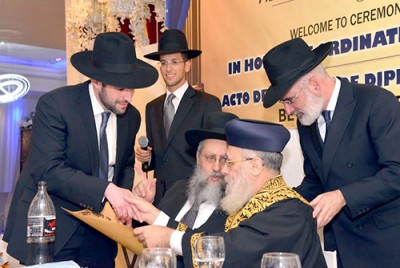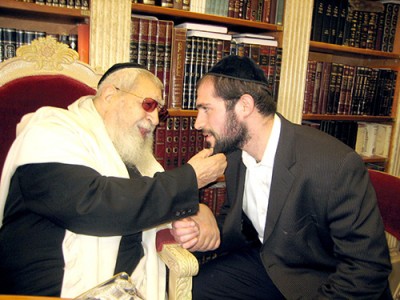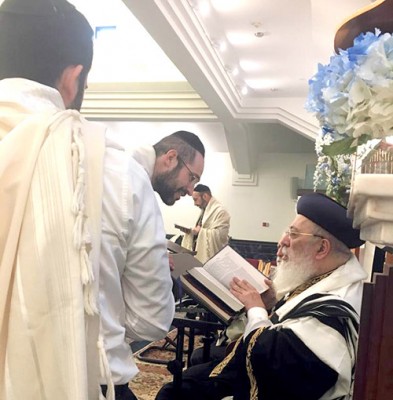




Our sages teach us of a thirst that is never slaked, but this is a blessing. “All who are thirsty go to the water… (Isaiah 55:1)”. It is a thirst born of love for the Creator and His teachings, teachings which fill the heart with wisdom and crown the mind in grandeur. The Jewish nation is entrusted with cherishing this gift from above, and many of its children carry out this responsibility with joy. Their reward is obvious; it is displayed for all to see. A thirst for the word of Hashem is a search for an Infinite light; it emanates from an Infinite Love. The students of the Torah are few in every generation, but their holy desire is forever insatiable. They marvel at their ability to share this gift with their fellow man, and so we are blessed with our own springs of water. It is therefore a pleasure to interview HaRav Meir Gavriel Elbaz.
BJL: Please tell our readers about yourself.
MGE: I was born on 19 Tevet, 5748 and grew up in Queens. For the first 12 years of my life, my family lived in Rego Park and we davened in Rabbi Hecht’s Shul. We then moved to Kew Garden Hills in September of 2000.
I went to Yeshiva Tiferes Moshe for elementary school and Mesivta Tiferes Yisroel for High School. After that, I spent six years in Beis Medrash of Mirer Yeshiva of Brooklyn and followed up with another seven years Kollel Yechavei Da’at of Eretz Yisrael.
My father’s family is originally from Sefrou, a small village in Morocco known for producing many Moroccan Talmidei Chachamim and luminaries. My mother was born to Romanian Holocaust survivors who moved to Trenton, New Jersey after escaping the destruction.
BJL: What it was like growing up Queens as the community was changing so drastically?
MGE: Rego Park was not experiencing a major influx of Soviet Jewry when I lived there. Things really began to pick up around the time I moved to Kew Garden Hills. Jewish demography in the area at the time was roughly 75% Ashkenaz and 25% Bukharian. Today the numbers have nearly reversed.
My father decided to buy a house next door to Ohel Simcha. There were pros and cons growing up near such a major hub; foot traffic and noise tended to be heavy. But my father’s primary consideration of living next to a shul led me to my first exposure to and positive experience of a Sephardi Makom Torah. I was very impressed with what I saw and this inspired me to consider the life of a ben Torah.
BJL: How did you finally decide to devote your life to Torah?
MGE: I always had a tendency towards Limud Hatorah and enjoyed it very much. I was also aware and very thankful for Hashem’s gift of good recall in my learning. My personal involvement spreading Torah goes back to when I was a young child in Rav Hecht’s shul; the Gabbaim would often ask me to say a small Dvar Torah during Kiddush following the early Minyan. I eventually realized that learning and disseminating Torah was something I would love to devote my life to. As I matured I enjoyed it more and more.
BJL: Can you give us a little more detail about the path you took as you developed your life of Torah learning?
MGE: I made my way through several different Litvishe yehshivot and then searched for a Beth Medrash program that would fit me best. Rav Aharon Walkin suggested I try the Mirrer Yeshiva and I found it to be a perfect fit. I felt a powerful connection with the Rosh Yeshiva at the time, Hagaon Harav Osher Kalmanowitz. In fact, he is my Rebbi until today. His father, Hagaon Harav Shraga Moshe Kalmanowitz, a close student of the Birkas Shmuel (Hagaon Harav Baruch Ber Leibowitz), was the Rosh Yeshiva before him and his grandfather, Hagaon Harav Avraham Kalmanowitz, established the Mirrer Yeshiva in Brooklyn and saved the entire Mirrer Yeshiva in Poland from extermination during World War II.
My father who went with me at the time of my Farher (entrance exam) later told me that he never before witnessed such warmth and respect emanating from a Rosh Yeshiva towards a potential student of my background. The Mirer yeshiva is legendary for its work with the Sephardi community; it saved Moroccan, Egyptian and Syrian Jewry, incorporating their sons into its exceptional Yeshiva system.
I passed the entrance exam, went through the Mirer Talmud learning cycle, and then stayed as an older student to focus on in-depth Halachic analysis. Halacha was always a deep interest of mine, but I made sure to always follow the system and priority of my Yeshiva to its completion. The analytical tools I gained by following the yeshiva system empowered me to delve into the topics I was most drawn to.
BJL: How and why did you decide to focus primarily on Halachic analysis in your studies?
MGE: I am infinitely grateful and fortunate to have rabbanim who recognized my natural disposition in Torah, and who worked to develop me along my inclined path by guiding me along the normative Yeshiva program. It is true there is a time and place for everything, but a good Rav must make sure to masterfully develop his student without stifling his natural strengths.
That being said, all of Torah is connected. A perceptive student realizes that all of Torah is unified and only superficially split into “subjects”. The Halacha often dips into mussar, and the Talmud regularly discusses Aggadatah etc.
Another important point to make is that children and young adults often don’t receive a fair share of Halacha in their standard Torah education. The result is that many times, wives are left to fend for themselves when they have a serious Halachic inquiry. It shouldn’t be this way. Men have a responsibility to their families; they need to know what to do when guidance from a Rav is unavailable.
A proper understanding of the Halacha and its parameters of application depends on a Gemarah background; all of Torah is connected. This is a reason why the Yeshiva system is so important. Without in-depth analysis of Talmud, one would not be able to understand the underpinnings of even a single Halacha, causing an opening for improper implementation.
When taking notes, I used to summarize every sugiya (portion) of Gemarah in the Yeshiva with a Rambam and Shulchan Aruch to get a fuller Halachic picture. This made way to a focus on Orach Chaim and other advanced Halachic treatises while I was still in Yeshiva. I had a reputation, but everyone knew that I would never compromise the yeshiva sedarim (classes) for my hobby, if you will. My fascination with the Halacha gave me expertise, but it never came at the expense of the Yeshiva schedule and system. The tools being honed by the Yeshiva system and methodology should not be traded for an unbalanced focus in any other subject.
Harav Meir Gavriel Elbaz is a Rav for the Ohel Simcha Sephardic congregation of Kew Garden Hills. He also teaches in the Yeshiva’s night kollel Sunday’s through Thursday’s, 8:45pm to 10pm.
By Adam Suionov
Torah Be’Ahava: Interviewing Harav Meir Gavriel Elbaz
Typography
- Smaller Small Medium Big Bigger
- Default Helvetica Segoe Georgia Times
- Reading Mode



